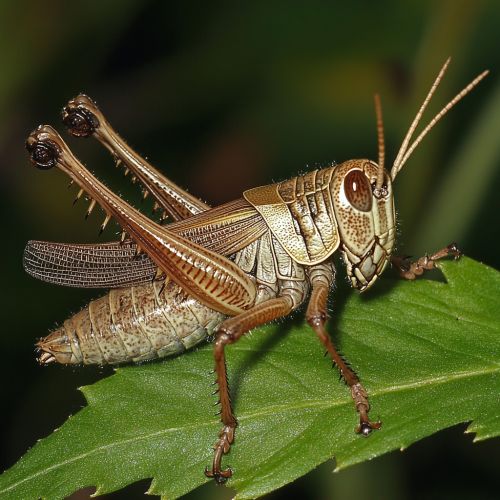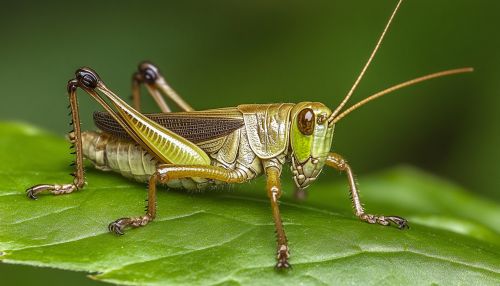Short-horned Grasshoppers
Introduction
Short-horned grasshoppers, belonging to the family Acrididae, are a diverse group of insects within the order Orthoptera. Characterized by their relatively short antennae, these grasshoppers are found in a variety of habitats worldwide, from grasslands and savannas to forests and agricultural fields. They play a significant role in ecosystems as both herbivores and prey for various predators. This article delves into the taxonomy, morphology, behavior, ecology, and economic importance of short-horned grasshoppers, providing a comprehensive overview of these fascinating insects.
Taxonomy and Classification
The family Acrididae is one of the largest families within the order Orthoptera, comprising over 10,000 species. These species are distributed across numerous genera, with some of the most well-known being Schistocerca, Melanoplus, and Locusta. The classification of short-horned grasshoppers is based on morphological characteristics such as wing structure, antennae length, and genitalia, as well as molecular data.
Subfamilies
Acrididae is divided into several subfamilies, each with distinct characteristics:
- **Cyrtacanthacridinae**: Known for their large size and migratory behavior, this subfamily includes the infamous desert locust.
- **Gomphocerinae**: Often referred to as slant-faced grasshoppers, they are characterized by their elongated heads.
- **Oedipodinae**: This group includes band-winged grasshoppers, recognized by their brightly colored hind wings.
Morphology
Short-horned grasshoppers exhibit a range of morphological adaptations that facilitate their survival in diverse environments. Their bodies are typically divided into three main sections: the head, thorax, and abdomen.
Head
The head of a short-horned grasshopper is equipped with compound eyes, which provide a wide field of vision. The antennae, although shorter than those of long-horned grasshoppers, are crucial for sensory perception. The mouthparts are adapted for chewing, with strong mandibles that allow them to feed on a variety of plant materials.
Thorax
The thorax is divided into three segments: the prothorax, mesothorax, and metathorax. Each segment bears a pair of legs, with the hind legs being significantly larger and adapted for jumping. The mesothorax and metathorax also support the wings, which vary in size and functionality among different species.
Abdomen
The abdomen houses the digestive and reproductive organs. In many species, the terminal segments of the abdomen are modified to form genitalia, which are used for mating.


Behavior
Short-horned grasshoppers exhibit a range of behaviors that are crucial for their survival and reproduction.
Feeding
These insects are primarily herbivorous, feeding on grasses, leaves, and other plant materials. Their feeding habits can have significant impacts on vegetation, particularly in agricultural areas where they may become pests.
Locomotion
Short-horned grasshoppers are known for their powerful jumping ability, which is facilitated by their large hind legs. This form of locomotion is energy-efficient and allows them to escape predators quickly.
Communication
Grasshoppers communicate primarily through sound, produced by stridulation, where they rub their hind legs against their wings. These sounds are used for mating calls and territorial displays.
Ecology
Short-horned grasshoppers are integral components of many ecosystems, serving as both consumers and prey.
Habitat
These grasshoppers inhabit a wide range of environments, from arid deserts to lush forests. Their adaptability allows them to thrive in diverse climatic conditions.
Role in the Food Web
As herbivores, short-horned grasshoppers play a crucial role in controlling plant populations. They are also a vital food source for numerous predators, including birds, reptiles, and small mammals.
Economic Importance
While short-horned grasshoppers are essential for ecological balance, they can also pose challenges for human activities.
Agricultural Impact
Some species, such as the desert locust, are notorious for their swarming behavior, which can lead to significant crop damage. These swarms can devastate agricultural regions, leading to economic losses and food shortages.
Pest Management
Efforts to manage grasshopper populations include biological control, chemical pesticides, and habitat management. Understanding the life cycle and behavior of these insects is crucial for developing effective control strategies.
Conservation
The conservation status of short-horned grasshoppers varies widely among species. While some are abundant and widespread, others face threats from habitat loss and environmental changes. Conservation efforts focus on habitat preservation and sustainable land management practices.
